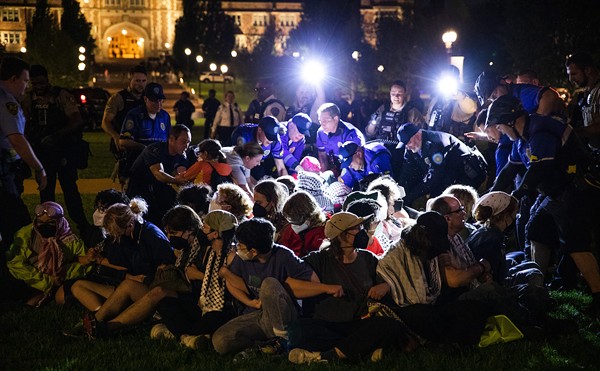An attorney who represents one of the famous people whose name the story features prominently called today to inform us that as far as it concerns their client, the piece is "entirely false" and has "no basis in truth whatsoever."
Whaddaya know? The principals of a company known and admired the world over (and their general counsel!) are reading li'l ol' Riverfront Times!
They did have a smidgen of constructive criticism to offer. In legal circles, the term is retraction.
The story below is a work of satire. You know, like Jonathan Swift -- only instead of cooking up children we put Emily Pulitzer, Frank Gehry, the St. Louis Cardinals, Mike Shannon and Stanley Elkin in the pot, and stirred. The entre that emerged lampoons the posturing of Cardinals ownership and city muckamucks around Ballpark Village (a.k.a. The Crater Formerly Known As Busch Stadium). It was inspired by a kernel of truth: namely, that last month the Cardinals reminded the city that the ballclub had only agreed to commit $60 million to redevelop the now-vacant site, and that it takes a few hundred million more to build a Village. From there we pretty much made it up, from Pulitzer's machinations to Gehry's illustrations to Shannon's protestations.
We trust you get the idea.
No matter how far removed in time and space Frank O. Gehry might be from his Jewish childhood in Toronto, he has never lost track of memories of his grandmother and the carp.
In his boyhood, carp were brought home from the fishmonger to languish in the bathtub until it was time for their transformation into gefilte fish.
Throughout a long and distinguished career, one blessed with celebrity and critical and financial rewards, Gehry has carried the fish with him, employing its shape literally and abstractly. The sensual curves of his Guggenheim Museum in Bilbao are as clear references as references can be. So also is the fish that figures in the proposal for Ballpark Village in St. Louis.
Look carefully at the direction that fish form is swimming. It is hightailing it away from the 2006 iteration of Busch Stadium, an eighth- or ninth-generation version of Camden Yards, a style of building so commonplace now that a generation of kids are going to think these conglomerations of bits and pieces of our architectural past, cobbled together in a collage of nostalgic ridiculousness, are what baseball stadiums should look like.
But in fact, ballparks needn't "look" like anything in particular. Were I to design one, it would be a hemisphere of Carrara marble with Missouri red granite set into the white stone to resemble stitching.
Should the entirely more plausible modernist village be built, and were our children to pay attention to the direction that fish is headed — i.e. toward buildings that would rise triumphantly and dramatically from the earth with authority and optimism — perhaps they and we would have a better idea of what matters in civic architecture.
The recently destroyed Busch II, by Edward Durell Stone, looked sort of like the Flavian Amphitheater in Rome — but only sort of. Busch II was not a new Colosseum but a clear, modern reinterpretation of one. Its coronet of arches directed the eye and the imagination toward Eero Saarinen's magical, silvery, gravity-defying river of steel, the Gateway Arch. That monument to national expansion is a testament not only to past accomplishments but also an optimistic statement about the worthiness of adventure and risk and progress that may result from them.
Plans and renderings are not always clear indications of what is to be; all too often in their realization they fall short of their paper promises. These village plans have a rather speculative air, if not a fantastical one, and the designer seems to perform a Gehry-Libeskind marriage in them.
But what is evident and affecting is an intention to create an architecture of vitality downtown, one that embraces the past (sometimes literally and materially, as in the relocation of the Kiel Opera House) but also effectively turns its back on the risible and contemptible pile across Clark Street from it. It moves toward the central business district and in crescendo rises to a zenith looking skyward toward the light, the sun, the moon and the stars.
We can only fantasize that a project such as this might be realized. Preliminary plans for the Ballpark Village were fantasies of a different order — theme park fantasies — with Prairie School piping to suggest some architectural sophistication.
This plan, bold, courageous and eager to involve itself in the city with dynamism and good humor, should be cheered on by fans of all sorts, chief among them those who would promote a rich future for the region.
We're offered a triple play here, Redbird lovers: a gigantic financial dilemma solved; architecture of contrast and distinction and redemption; and at least a dozen good reasons to come downtown again. Play ball!





